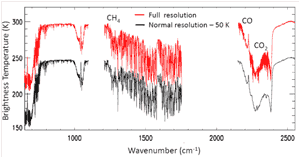- STAR Home
- > SMCD Home
- > Suomi NPP CrIS Full Spectral Resolution SDR Products using STAR Offline Processing System
Demonstrating Suomi NPP CrIS Full Spectral Resolution SDR Products using STAR Offline Processing System
Principal Investigator: Yong Han

Click to enlarge - an example of CrIS FSR (red line) and normal
spectral resolution (black line, offset by 50 K) spectra. The spectral
resolutions of the FSR mid-wave and shortwave bands are increased by
factors 2 and 4, respectively, in comparison to those of the NSR SDRs.
Channels sensitive to the carbonate gases in the two bands are labeled
with CH4 (1210 - 1400 cm-1), CO (2155-2190 cm-1) and CO2 (2300-2370 cm-1).
NOAA/STAR has developed a ground processing system to generate the
full spectral resolution (FSR) Sensor Data Records (SDRs) for the Cross-
Track Infrared Sounder (CrIS) instrument onboard the Suomi National
Polar-Orbiting Partnership (S-NPP) satellite. This achievement laid the
ground work for the data production, and demonstrated the S-NPP FSR SDR
products. Started on December 04, 2014, when the CrIS was commanded to
the FSR mode operation from the normal spectral resolution (NSR) mode
operation, STAR routinely produces the FSR SDRs, available to the public
via the STAR FTP site with a data latency of less than 12 hours. The FSR
SDR includes a total of 2211 spectral channels, a substantial increase
from the 1305 channels of the normal spectral resolution (NSR) SDRs,
which continue to be generated by the NOAA operational processing system
after the CrIS FSR transition. Figure 5 shows an example of the FSR and
NSR spectra. The spectral resolutions of the FSR mid-wave and shortwave
bands are increased by factors 2 and 4, respectively, in comparison to
those of the NSR SDRs. The FSR radiance data are critical for retrieving
carbonate products such as carbon monoxide (CO), carbon dioxide (CO2)
and methane (CH4). In addition, the increase of the information content
from the FSR radiance data on atmospheric temperature and water vapor
improves the numerical weather prediction (NWP). STAR is utilizing the
CrIS FSR data in the NOAA-Unique CrIS/ATMS (Advanced Technology
Microwave Sounder) Processing System to generate carbonate products.
The development of the FSR SDR processing system was challenging in
both algorithm and software, because the current SDR algorithms designed
for the NSR SDRs do not work correctly for the FSR SDR processing and
the current SDR software was not scalable to accommodate the increased
dimensions of the FSR data. The new and improved algorithms include
self-apodization correction, spectrum resampling, radiance noise
estimation and dynamic update of the Correction Matrix Operator (CMO). A
modification of the self-apodization correction algorithm was made in
order to remove large radiance ringing artifacts in the shortwave band
due to an inappropriate expansion factor, which results in the breakdown
of energy conservation when applied to the FSR SDR processing. The
resampling matrix calculation is reformulated in the un-decimated
spectral domain rather than decimated domain to avoid the negative
impact of the guard bands in which the signals are contaminated with
noise. The FSR noise calculation includes the spectral calibration,
which is ignored in the NSR processing, to take into account the noise
contributions from spectral calibration in the mid- and short-wave bands
due to increased spectral resolutions in these two bands. The new CMO
handling algorithm is developed to improve spectral accuracy by more
frequent updates of the CMO matrix since the spectra with increased
spectral resolution is more sensitive to spectral calibration
uncertainty.
Substantial work was done to upgrade the SDR software and create a
computational environment within which the FSR processing is automatic
and efficient. The FSR SDR software includes a new framework that
resolves the key issue of the backward compatibility and one source code
for both FSR and NSR SDR processing. The STAR FSR SDR processing system
is required to process the data in near real-time on an ordinary Linux
computer. To meet this requirement, an efficient computational
environment was developed to manage input and output data and data
processing in a parallel computing fashion.
|

